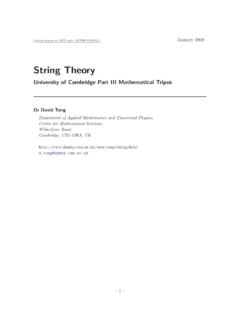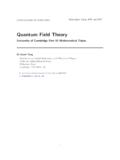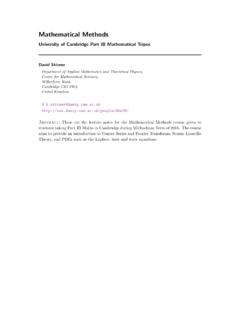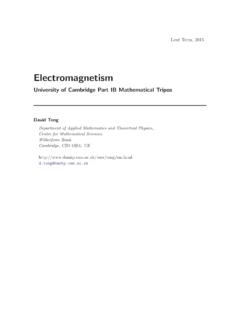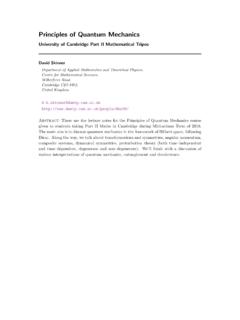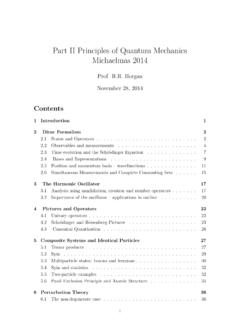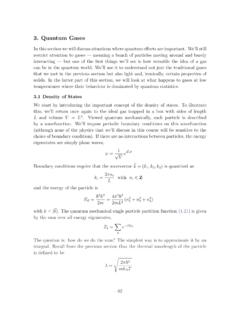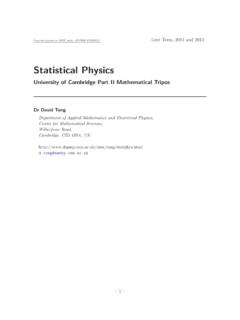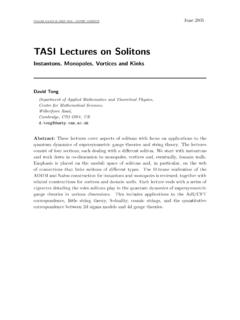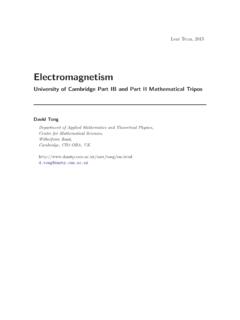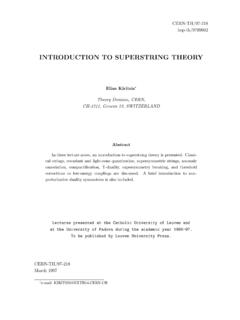Transcription of String Theory - DAMTP
1 Preprint typeset in JHEP style - HYPER VERSION January 2009. String Theory University of Cambridge Part III Mathematical Tripos Dr David Tong Department of Applied Mathematics and Theoretical Physics, Centre for Mathematical Sciences, Wilberforce Road, Cambridge, CB3 OWA, UK. 1 . Recommended Books and Resources J. Polchinski, String Theory This two volume work is the standard introduction to the subject. Our lectures will more or less follow the path laid down in volume one covering the bosonic String . The book contains explanations and descriptions of many details that have been deliberately (and, I suspect, at times inadvertently) swept under a very large rug in these lectures. Volume two covers the superstring . M. Green, J. Schwarz and E. Witten, superstring Theory Another two volume set.
2 It is now over 20 years old and takes a slightly old-fashioned route through the subject, with no explicit mention of conformal field Theory . How- ever, it does contain much good material and the explanations are uniformly excellent. Volume one is most relevant for these lectures. B. Zwiebach, A First Course in String Theory This book grew out of a course given to undergraduates who had no previous exposure to general relativity or quantum field Theory . It has wonderful pedagogical discussions of the basics of lightcone quantization. More surprisingly, it also has some very clear descriptions of several advanced topics, even though it misses out all the bits in between. P. Di Francesco, P. Mathieu and D. Se ne chal, Conformal Field Theory This big yellow book is affectionately known as the yellow pages.
3 It's a great way to learn conformal field Theory . At first glance, it comes across as slightly daunting because it's big. (And yellow). But you soon realise that it's big because it starts at the beginning and provides detailed explanations at every step. The material necessary for this course can be found in chapters 5 and 6. Further References: String Theory and M- Theory by Becker, Becker and Schwarz and String Theory in a Nutshell (it's a big nutshell) by Kiritsis both deal with the bosonic String fairly quickly, but include more advanced topics that may be of interest. The book D-Branes by Johnson has lively and clear discussions about the many joys of D-branes. Links to several excellent online resources, including video lectures by Shiraz Minwalla, are listed on the course webpage.
4 Contents 0. Introduction 1. Quantum Gravity 3. 1. The Relativistic String 9. The Relativistic Point Particle 9. Quantization 11. Ein Einbein 13. The Nambu-Goto Action 14. Symmetries of the Nambu-Goto Action 17. Equations of Motion 18. The Polyakov Action 18. Symmetries of the Polyakov Action 20. Fixing a Gauge 22. Mode Expansions 25. The Constraints Revisited 26. 2. The Quantum String 28. A Lightning Look at Covariant Quantization 28. Ghosts 30. Constraints 30. Lightcone Quantization 32. Lightcone Gauge 33. Quantization 36. The String Spectrum 40. The Tachyon 40. The First Excited States 41. Higher Excited States 45. Lorentz Invariance Revisited 46. A Nod to the superstring 48. 3. Open Strings and D-Branes 50. Quantization 53. The Ground State 54. First Excited States: A World of Light 55.
5 1 . Higher Excited States and Regge Trajectories 56. Another Nod to the superstring 56. Brane Dynamics: The Dirac Action 57. Multiple Branes: A World of Glue 59. 4. Introducing Conformal Field Theory 61. Euclidean Space 62. The Holomorphy of Conformal Transformations 63. Classical Aspects 63. The Stress-Energy Tensor 64. Noether Currents 66. An Example: The Free Scalar Field 67. Quantum Aspects 68. Operator Product Expansion 68. Ward Identities 70. Primary Operators 73. An Example: The Free Scalar Field 77. The Propagator 77. An Aside: No Goldstone Bosons in Two Dimensions 79. The Stress-Energy Tensor and Primary Operators 80. The Central Charge 82. c is for Casimir 84. The Weyl Anomaly 86. c is for Cardy 89. c has a Theorem 91. The Virasoro Algebra 92. Radial Quantization 92.
6 The Virasoro Algebra 94. Representations of the Virasoro Algebra 96. Consequences of Unitarity 98. The State-Operator Map 99. Some Simple Consequences 101. Our Favourite Example: The Free Scalar Field 102. Brief Comments on Conformal Field Theories with Boundaries 105. 5. The Polyakov Path Integral and Ghosts 108. The Path Integral 108. The Faddeev-Popov Method 109. 2 . The Faddeev-Popov Determinant 112. Ghosts 113. The Ghost CFT 114. The Critical Dimension of String Theory 117. The Usual Nod to the superstring 118. An Aside: Non-Critical Strings 119. States and Vertex Operators 120. An Example: Closed Strings in Flat Space 122. An Example: Open Strings in Flat Space 123. More General CFTs 124. 6. String Interactions 125. What to Compute? 125. Summing Over Topologies 127.
7 Closed String Amplitudes at Tree Level 130. Remnant Gauge Symmetry: SL(2,C) 130. The Virasoro-Shapiro Amplitude 132. Lessons to Learn 135. Open String Scattering 139. The Veneziano Amplitude 141. The Tension of D-Branes 142. One-Loop Amplitudes 143. The Moduli Space of the Torus 143. The One-Loop Partition Function 146. Interpreting the String Partition Function 149. So is String Theory Finite? 152. Beyond Perturbation Theory ? 153. Appendix: Games with Integrals and Gamma Functions 154. 7. Low Energy Effective Actions 157. Einstein's Equations 158. The Beta Function 159. Ricci Flow 163. Other Couplings 163. Charged Strings and the B field 163. The Dilaton 165. Beta Functions 167. The Low-Energy Effective Action 167. 3 . String Frame and Einstein Frame 168. Corrections to Einstein's Equations 170.
8 Nodding Once More to the superstring 171. Some Simple Solutions 173. Compactifications 174. The String Itself 175. Magnetic Branes 177. Moving Away from the Critical Dimension 180. The Elephant in the Room: The Tachyon 183. D-Branes Revisited: Background Gauge Fields 183. The Beta Function 184. The Born-Infeld Action 187. The DBI Action 188. Coupling to Closed String Fields 189. The Yang-Mills Action 191. D-Branes in Type II superstring Theories 195. 8. Compactification and T-Duality 197. The View from Spacetime 197. Moving around the Circle 199. The View from the Worldsheet 200. Massless States 202. Charged Fields 202. Enhanced Gauge Symmetry 203. Why Big Circles are the Same as Small Circles 204. A Path Integral Derivation of T-Duality 206. T-Duality for Open Strings 207.
9 T-Duality for Superstrings 208. Mirror Symmetry 208. Epilogue 209. 4 . Acknowledgements These lectures are aimed at beginning graduate students. They assume a working knowledge of quantum field Theory and general relativity. The lectures were given over one semester and are based broadly on Volume one of the book by Joe Polchinski. I. inherited the course from Michael Green whose notes were extremely useful. I also benefited enormously from the insightful and entertaining video lectures by Shiraz Minwalla. I'm grateful to Anirban Basu, Niklas Beisert, Joe Bhaseen, Diego Correa, Nick Dorey, Michael Green, Anshuman Maharana, Malcolm Perry and Martin Schnabl for discus- sions and help with various aspects of these notes. I'm also grateful to the students, especially Carlos Guedes, for their excellent questions and superhuman typo-spotting abilities.
10 Finally, my thanks to Alex Considine for infinite patience and understanding over the weeks these notes were written. I am supported by the Royal Society. 5 . 0. Introduction String Theory is an ambitious project. It purports to be an all-encompassing Theory of the universe, unifying the forces of Nature, including gravity, in a single quantum mechanical framework. The premise of String Theory is that, at the fundamental level, matter does not consist of point-particles but rather of tiny loops of String . From this slightly absurd beginning, the laws of physics emerge. General relativity, electromagnetism and Yang-Mills gauge theories all appear in a surprising fashion. However, they come with baggage. String Theory gives rise to a host of other ingredients, most strikingly extra spatial dimensions of the universe beyond the three that we have observed.
